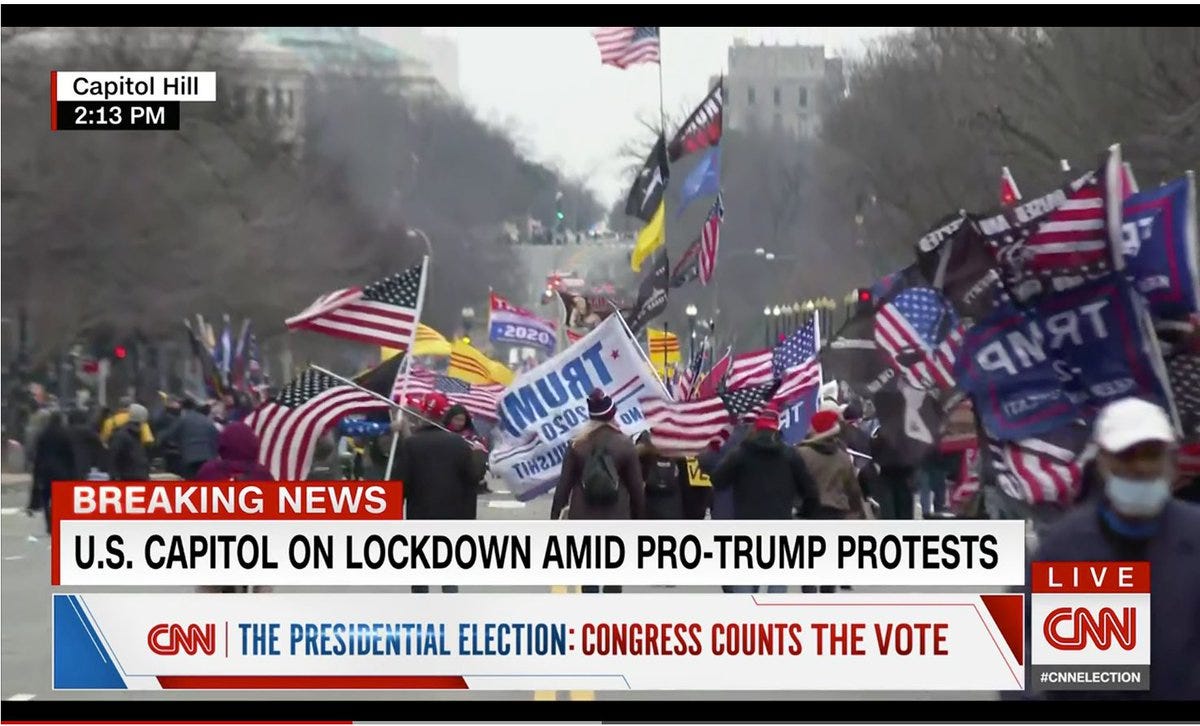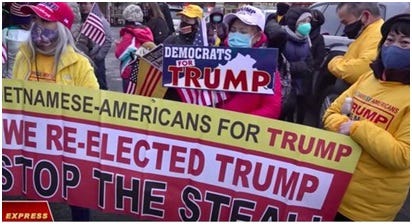[ad_1]

By: Tun Hoang
Among the American, Trump, Tea Party, and Confederacy flags that turned up in the January 6 invasion of the Capitol in Washington, DC plus a small number of national flags of Australia, Japan, South Korea, etc, was the flag of the Republic of Vietnam (RVN), which had ceased to exist in 1975.
Why did the three-red-stripes-on-yellow flag pop up at this terrible event?
The answer is long and complex. A short answer is that like other flags, its presence signifies support of a group for Trump – in this case, support from a sizable number of Vietnamese Americans. Their biggest and most apparent reason is that Trump was the best-suited and toughest person to stand up against China, whose expansionist and imperial designs have harmed Vietnam in recent decades. In their view, the Chinese Communist Party (CCP) is bent on territorial and other forms of gains and control vis-à-vis a largely impotent Vietnamese government.
Anti-Chinese and/or anti-CCP sentiments are hardly exclusive to first- and 1.5-generation Vietnamese Americans. These sentiments are shared among groups as different as Chinese dissidents and immigrants from the Philippines. Surveys have indicated that similar to Vietnamese Americans, a lot of Filipino immigrants have supported and voted for Trump. In fact, Trumpism has been stronger in Vietnam during the last few years than it is in the diaspora. Even though I haven’t seen surveys or studies about Vietnam, anecdotal evidence suggests that it has been overwhelming.

Photo from VOA Tiếng Việt
Logically, then, one would have expected to see the current flag of Vietnam among other national flags on January 6. However, the majority of Vietnamese refugees and immigrants in the US came from what was South Vietnam and have tended to identify with the anti-communist RVN. Anticommunism, however, didn’t mean warmth towards the US during the war, given American tendency to call the shots in war-making. As a number of historians, including myself, have found out in research, anti-Americanism in South Vietnam was substantial and varied: a result of nationalism, colonialism, and other factors.
Indeed, the first waves of refugees arrived on American shores with the belief that the US had “abandoned” South Vietnam. They viewed the US government with skepticism at best and anger and resentment at worst. They were grateful to American society, including churches and religious organizations, for helping them resettle. But it was also an ambivalent gratitude: a more complex kind than it was presented by Americans. For a host of reasons, Vietnamese refugees eventually became more positive about the US. Some of the reasons had to do with developments in Vietnam: the collectivized economy, reeducation camps, the boat people crisis, etc. Some were American or global in origin: e.g., the late President Ronald Reagan’s anti-communist rhetoric before negotiation with Gorbachev, the end of the Cold War and notions of model minority and model immigrants and model refugees. Another long and complex history there.
The RVN flag was (and is) a common sight at Vietnamese American events. Already deeply nationalistic, its symbolism was even more potent among refugees during the 1970s and 1980s. Not only were their identity and history being erased by the postwar regime, there was also little if any representation of this identity and history in the US: no museums, statues, official commemoration, formal recognition, etc. The RVN flag and anthem were among the few things that kept alive the identity and political memories of the refugees.
This background provides a key to understanding the sight of RVN flags on January 6: just as there is a history to the Vietnamese American experience, there is a history to the visibility of this flag. During the 1970s and 1980s, the RVN flag appeared mostly at ethnic events. One would have seen it at Vietnamese cultural and political events such as Tết gatherings and annual commemorations of the fall of Saigon. In addition to the sight of the flag, the RVN anthem was typically sung during these ceremonies and events. From the visual evidence that I’ve seen, there were some flags at those events but not a lot. On occasions, the flag also appeared at non-ethnic events, events organized and/or participated mainly by non-Vietnamese. But only occasionally and not frequently.
The 1990s saw notable changes to both Vietnamese American history and the history of the flag’s visibility. That decade saw the arrival of a critical mass of former reeducation camp political prisoners and their families, who injected fresh political energy into Vietnamese communities. The RVN flag and anthem became even more important as symbols. Numerically, there were many more flags at ethnic events. The 1990s also saw the now-common sight of former South Vietnamese military officers wearing military clothing at ethnic events. It too reflects the experience of erasure and identity. Flags and, to a lesser extent, military uniforms were common at political rallies, fundraisers, reunions, funerals, and other Vietnamese events. There were many more of such events in comparison to the earlier decades, and also many more flags.
There was also a greater visibility of the RVN flag at non-ethnic events. A number of reasons emerged to bring about this visibility. There were, for example, greater efforts to repair the ambivalent wartime relationship between US and RVN veterans. Or, many 1.5 and second-generation Vietnamese Americans joined the US armed forces, whose reverence for flags is expected and well known. Or, younger Vietnamese began to view the RVN flag as the “heritage flag.” Some city councils have recognized the RVN flag as a representation of Vietnamese American communities. Post-9/11 US nationalism might have been a contributing factor. Homeland politics, especially regarding China, was definitely a contributing factor.
Moving into the 2010s, the greater visibility of this flag at non-ethnic events might have signaled something new: possibly an overlap between homeland politics and greater incorporation into US politics. During the 2016 election and especially the 2020 election, this flag was visible at many non-ethnic Trump rallies. Unsurprisingly, there were many more of them at rallies in Little Saigons across the US. The RVN flag became a signifier for Trump supporters. The sightings of this flag on January 6 indicate that some Vietnamese supporters of Trump continued to believe in his claims about the election.
There is a lot more to this story, both within the US and across the Pacific. There are also many angles on gender, religion, racial relations (especially racism against Blacks), and convergences and divergences from other Asian American groups. At the least, I hope that this background provides an explanation for the visibility of the RVN flag at the rally that turned into riot on January 6.
Dr. Tuan Hoang is an associate professor at Pepperdine University in California. A version of this appeared on his Facebook page on January 8, 2021.
This article is among the stories we choose to make widely available. If you wish to get the full Asia Sentinel experience and access more exclusive content, please do subscribe to us.
[ad_2]
Source link